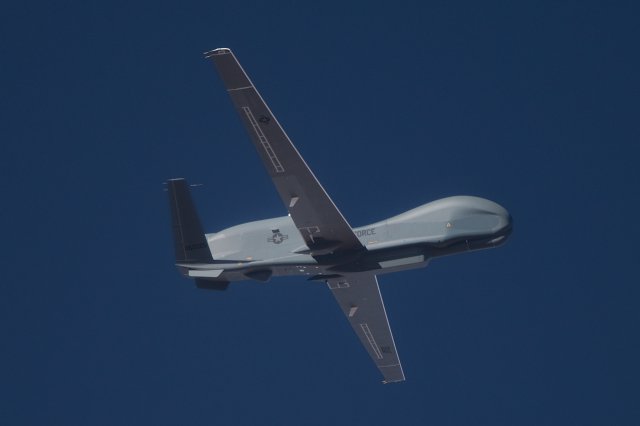 In early talks on the forthcoming fiscal 2014 budget request, the U.S. Air Force is proposing to close the book on Northrop Grumman’s Global Hawk franchise, canceling the ground surveillance variant.
In early talks on the forthcoming fiscal 2014 budget request, the U.S. Air Force is proposing to close the book on Northrop Grumman’s Global Hawk franchise, canceling the ground surveillance variant.
The so-called Block 40 aircraft, built on the high-flying Global Hawk platform, is, at least for now, being proposed for termination to pay bills for higher-priority programmes for the service, according to multiple programme officials.
If accepted by the Pentagon and Congress, this proposal would end the life of the long-awaited Northrop Grumman aircraft before it even gets much operational experience. The company declined to comment on the issue, noting that a termination is “speculation until we have more information,” according to spokeswoman Gemma Loochkartt.
Forced to continue business as usual until a final decision is made, the Global Hawk program office is continuing with plans to conduct an operational utility evaluation (OUE) of the system in advance of possible early deployment to support operations in U.S. Central Command. Deputy Defense Secretary Ashton Carter made the decision to conduct the OUE on April 12, 2012, to assess whether the aircraft and its Northrop Grumman-Raytheon Multi-Platform Radar Technology Insertion Program (MP-RTIP) sensor will “deliver limited, but high-demand capability to warfighters in Centcom this spring,” according to Air Force programme officials at Wright-Patterson AFB, Ohio.
The evaluation will include two aircraft, each outfitted with the sophisticated MP-RTIP active electronically scanned array radar, collectively performing four long-duration sorties. Among the issues to be reviewed will be the ability of the service’s pilots, sensor operators and maintainers to generate sorties and “fly missions in an operational environment.”
But even if the programme, which has suffered numerous setbacks, including a fitful sensor development, proves its utility, it may have already missed its window of opportunity to enter the Pentagon’s arsenal. The termination would come after the service struggled for years to calibrate and complete testing of the radar.
Senior Air Force officials agree that the aircraft should come out of service in 2015, shortly after U.S. forces pull out of Afghanistan, based on current plans. Talk of a Block 40 kill has been rampant at the Pentagon; one defence source said this was a “lit fuze” and only last week gave the program a “50/50 chance” at survival in today’s tight budget environment.
The MP-RTIP radar, measuring 1.5 ft. by 4 ft., was designed to track moving ground targets and collect radar images. Its unique quality is that the radar is designed to do these simultaneously; today’s manned Joint Surveillance Target Attack Radar System (Joint Stars, based on the Boeing 707) conducts this mission but cannot employ both modes at the same time. This forces crews to manually “break track” on targets while imaging them. A version of this radar is slated for use on NATO’s Alliance Ground Surveillance programme, also based on the Global Hawk. Though the Global Hawk’s sensor is far smaller than the Joint Stars radar, the aircraft is designed to stay aloft for longer than a day collecting data.
A Block 40 kill would end a tumultuous chapter in the Air Force’s relationship with Northrop Grumman, a key contractor also managing the stealthy B-2 and vying for the service’s next-generation bomber programme. The company is already embroiled in a fight to preserve the Block 30 Global Hawk, its highest legislative priority, which is designed to carry an electro-optical and infrared camera and signals-intelligence collection systems. Once slated to replace the venerable U-2, the Air Force abruptly abandoned its Block 30 plans in a budget proposal last year, offering to shelve all the aircraft built to date.
Northrop Grumman has delivered eight of 11 Block 40s on order, according to Alfredo Ramirez, chief engineer at Northrop. Sixteen Block 30s of 30 planned have been delivered, Loochkartt says. Early work on the next of each block is under way at the company’s Moss Point, Miss., facility, and both are slated for delivery in 2014.
Congress has moved to keep the Block 30 flying until 2014 despite the Air Force’s proposal to shelve it; aircraft are operating out of Al Dhafra Air Base in the United Arab Emirates and have been since late 2001 in support of post-9/11 operations abroad.
This leaves the Air Force with six Block 20 aircraft, two of which were quickly outfitted with the Battlefield Airborne Communication Node payload designed to enhance communications in Central Command.
Meanwhile, NATO’s work on the Global Hawk-based Alliance Ground Surveillance program continues, as does the U.S. Navy’s programme to outfit a Global Hawk for maritime surveillance. The Navy is slated to spend $11.4 billion developing and building 65 Broad Area Maritime Surveillance aircraft to augment its burgeoning P-8 fleet.
Source: Flight Global
